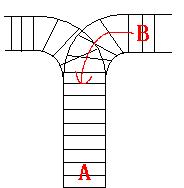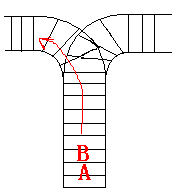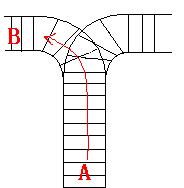Train Problem I
Time Limit: 2000/1000 MS (Java/Others) Memory Limit: 65536/32768 K (Java/Others)Total Submission(s): 27921 Accepted Submission(s): 10594
Problem Description
As the new term comes, the Ignatius Train Station is very busy nowadays. A lot of student want to get back to school by train(because the trains in the Ignatius Train Station is the fastest all over the world ^v^). But here comes
a problem, there is only one railway where all the trains stop. So all the trains come in from one side and get out from the other side. For this problem, if train A gets into the railway first, and then train B gets into the railway before train A leaves,
train A can't leave until train B leaves. The pictures below figure out the problem. Now the problem for you is, there are at most 9 trains in the station, all the trains has an ID(numbered from 1 to n), the trains get into the railway in an order O1, your
task is to determine whether the trains can get out in an order O2.






Input
The input contains several test cases. Each test case consists of an integer, the number of trains, and two strings, the order of the trains come in:O1, and the order of the trains leave:O2. The input is terminated by the end of file.
More details in the Sample Input.
Output
The output contains a string "No." if you can't exchange O2 to O1, or you should output a line contains "Yes.", and then output your way in exchanging the order(you should output "in" for a train getting into the railway, and "out"
for a train getting out of the railway). Print a line contains "FINISH" after each test case. More details in the Sample Output.
Sample Input
3 123 321 3 123 312
Sample Output
Yes. in in in out out out FINISH No. FINISH题目大意:一个火车调度站,输入火车进站的顺序和出站的顺序,问在进站的顺序下,能否按出站的顺序出来?如果可以,则输出Yes,并打印出进出的顺序;如果否,输出No;解题思路:本题就是利用栈的思想(后进先出的性质)来模拟;首先利用C++的STL建立一个栈;进展顺序和出站顺序分别存储在两个字符数组内;代码如下:#include<cstdio> #include<cstring> #include<stack> #include<algorithm> using namespace std; int main() { char a[10],b[10]; int i,j,k,x,y,flag,n; char str[20][20]; while(scanf("%d",&n)!=EOF) { scanf("%s %s",a,b); n=strlen(b); i=0,j=0,k=0,flag=1; stack<int>S; while(j<n) { if(a[i]==b[j]) //当此时的序号相同时,应执行进站出站的操作; { i++,j++; strcpy(str[k++],"in"); strcpy(str[k],"out"); k++; } else if(!S.empty()&&S.top()==b[j]) 当栈内不空,并且与当前序号相同,出栈; { j++; S.pop(); strcpy(str[k++],"out"); } else if(i<n) //否则,入栈 { S.push(a[i]); strcpy(str[k++],"in"); i++; } else //当上述都不能满足时,表示不能按出站顺序出去;直接跳出循环。 { flag=0;break; } } if(flag==1) { printf("Yes.\n"); for(i=0;i<k;i++) printf("%s\n",str[i]); } else printf("No.\n"); printf("FINISH\n"); } return 0; }










 本文探讨了在一个火车调度站中,如何通过利用栈的思想解决火车进出顺序的问题。通过输入火车进站和出站的顺序,判断是否能按照出站顺序让所有火车顺利离开。若可行,则给出操作步骤;否则输出不能实现。使用C++实现,通过遍历进站顺序,利用栈模拟火车进出过程。
本文探讨了在一个火车调度站中,如何通过利用栈的思想解决火车进出顺序的问题。通过输入火车进站和出站的顺序,判断是否能按照出站顺序让所有火车顺利离开。若可行,则给出操作步骤;否则输出不能实现。使用C++实现,通过遍历进站顺序,利用栈模拟火车进出过程。

















 733
733

 被折叠的 条评论
为什么被折叠?
被折叠的 条评论
为什么被折叠?










